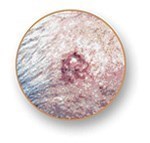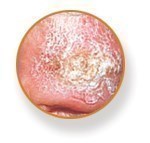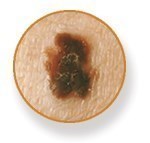Skin cancer is an abnormal growth of skin cells. It most often develops on areas of the skin exposed to the sun’s rays. Skin cancer affects people of all colors and races, although those with light skin who sunburn easily have a higher risk.
What does skin cancer look like?
Actinic Keratoses (AK)
These dry, scaly patches or spots are precancerous growths.

People who get AKs usually have fair skin.
Most people see their first AKs after 40 years of age because AKs tend to develop after years of sun exposure.
AKs usually form on the skin that gets lots of sun exposure, such as the head, neck, hands, and forearms.
Because an AK can progress to a type of skin cancer called squamous cell carcinoma (SCC), treatment is important.
Basal cell carcinoma (BCC)
This is the most common type of skin cancer. 
BCCs frequently develop in people who have fair skin, yet they can occur in people with darker skin.
BCCs look like a flesh-colored, pearl-like bump or a pinkish patch of skin.
BCCs develop after years of frequent sun exposure or indoor tanning.
BCC are common on the head, neck, and arms, yet can form anywhere on the body, including the chest, abdomen, and legs.
Early diagnosis and treatment for BCC is important. BCC can invade the surrounding tissue and grow into the nerves and bones, causing damage and disfigurement.
Squamous cell carcinoma (SCC)
SCC is the second most common type of skin cancer.

People who have light skin are most likely to develop SCC, yet they can develop in darker-skinned people.
SCC often looks like a red firm bump, scaly patch, or a sore that heals and then re-opens.
SCC tend to form on skin that gets frequent sun exposure, such as the rim of the ear, face, neck, arms, chest, and back. SCC can grow deep in the skin and cause damage and disfigurement. Early diagnosis and treatment can prevent this and stop SCC from spreading to other areas of the body.
Melanoma is the deadliest form of skin cancer.
 Melanoma frequently develops in a mole or suddenly appears as a new dark spot on the skin.Early diagnosis and treatment are crucial.
Melanoma frequently develops in a mole or suddenly appears as a new dark spot on the skin.Early diagnosis and treatment are crucial.
Knowing the ABCDE warning signs of melanoma can help you find an early melanoma.
